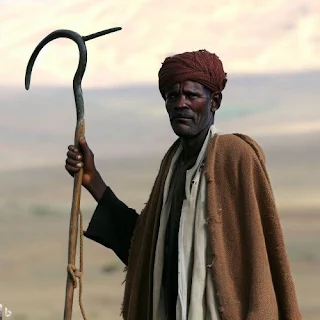Shepherds and Shepherd Crooks in Ethiopian History
Learn about Ethiopia, the country with the highest number of shepherds. Gain an understanding of the historical significance of the shepherd crook, a symbol of authority in Christianity and the Arts. Learn about the various ways in which shepherds utilize this tool to tend to their flocks.
Ethiopia is the Land of Shepherds and Ancient Shepherd Crooks.
According to a report by the Malabo Montpellier Panel, Ethiopia, Mali, South Africa, and Uganda are four African countries that have successful and sustainable livestock systems. Ethiopia has the most significant number of shepherds among these four countries, with about 12 million pastoralists who depend on livestock. Ethiopia also has the largest livestock population in Africa, with about 60 million cattle, 30 million sheep, and 30 million goats.
Shepherds have a long and rich history in Ethiopia, a country with a predominantly pastoral society. Shepherds play an important role in the culture and economy of Ethiopia, as they care for sheep and goats that provide meat, milk, wool, and leather.
Shepherds in Ethiopia are not only a part of history but also a part of present-day reality. They still play a vital role in the rural areas of Ethiopia, where they face many challenges, such as drought, famine, conflict, and disease. They also face threats from environmental degradation, urbanization, and modernization that affect their traditional way of life. Shepherds in Ethiopia deserve recognition and appreciation for their past achievements and present challenges.
The Shepherd Crook is a tool for teaching and tending flocks.
A shepherd crook is a long wooden staff with a curved end that shepherds use to manage their flocks. The crook can catch individual sheep by hooking their legs or necks, guiding them in a particular direction, or separating them from the rest of the flock. The crook can also be used as a weapon to defend against predators or thieves or as a walking stick to support the shepherd on rough terrain.
The origins of the shepherd crook can be traced back to ancient times when shepherding was one of the oldest and most important professions in human history. The earliest known examples of shepherd crooks date back to 3685 BC in Mesopotamia, now modern-day Iraq. These crooks were depicted on clay tablets and seals.
Even in contemporary times, the shepherd crook remains a valuable tool for many shepherds across the globe, particularly in rural areas where age-old herding techniques are still prevalent.
The history behind, the shepherd crook is a symbol of authority in Christianity and the Arts.
Christianity is the largest religion in Ethiopia, with about 65% of the population identifying as Christians. The history of Christianity in Ethiopia goes back to the 4th century AD when King Ezana of Aksum converted to the faith and made it the official religion of his kingdom. Ethiopia is one of the first countries in the world to adopt Christianity as a state religion.
In Christianity, the shepherd crook symbolizes Jesus Christ as the Good Shepherd who lovingly tends to his flock and ensures their safety. This powerful image has been used for centuries to inspire faith and hope among believers, reminding them of the comforting presence of a caring and compassionate God who will always guide them toward righteousness and salvation. The shepherd crook reminds Christians of the importance of living a life of kindness, compassion, and service to others, just as Jesus did during his time on earth.
One of the most notable examples of Ethiopian art that portrays shepherds is a mural in the church of Debre Berhan Selassie in Gondar. The mural shows a scene from the life of King David, who was a shepherd before he became a king. The mural portrays David as a young boy playing the harp while watching over his flock. The mural is part of a more extensive series that illustrates the genealogy of Jesus from Abraham to Mary.
The mural shows David as a symbol of piety, wisdom, and prophecy. He is also a link between Ethiopia and Israel, as he is believed to be an ancestor of Emperor Menelik I, who was said to be the son of King Solomon and Queen Sheba. The mural reflects the Ethiopian tradition of identifying with biblical figures and stories.
Shepherds in Ethiopia have inspired not only artists but also poets and musicians. One of the most famous poets in Ethiopia is Tsegaye Gabre-Medhin, born in Boda village near Ambo in 1936. He grew up among shepherds and farmers and learned to appreciate their oral literature and folklore. He later became a prominent playwright, poet, and cultural activist who wrote in both Amharic and English.
Tsegaye Gabre-Medhin wrote many poems that celebrate the beauty and diversity of Ethiopia, as well as its challenges and struggles. He also wrote poems that expressed his admiration and respect for shepherds, such as "Shepherd Boy" and "The Shepherd's Lament." In these poems, he portrays shepherds as noble, wise, and courageous people who endure hardship and danger for their flock. He also compares shepherds to poets with unique insight into nature and humanity.
Did you know that in addition to modern-day shepherds, the Ancient Egyptians, Greeks, and Romans also used the shepherd crook? In fact, they viewed it as a symbol of the gods and goddesses associated with agriculture and fertility. This practice has been passed down through the ages, and the shepherd crook holds significant cultural and historical value.











